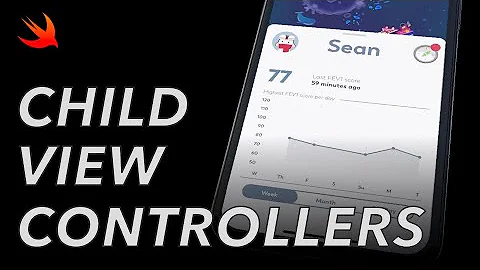View on top of everything: UIWindow subview VS UIViewController subview
Solution 1
The best solution I've found is to create a transparent container view, add that container to the window, and place your alert inside the container. You may then register for UIApplicationWillChangeStatusBarOrientationNotification to receive rotation events and transform the container; this allows you to independently manipulate the frame of the alert:
- (BOOL)application:(UIApplication *)application didFinishLaunchingWithOptions:(NSDictionary *)launchOptions
{
...
self.container = [[UIView alloc] initWithFrame:self.window.bounds];
[self.container addSubview:self.alertView];
[self.window addSubview:self.container];
[[NSNotificationCenter defaultCenter] addObserver:self
selector:@selector(statusBarWillRotate:)
name:UIApplicationWillChangeStatusBarOrientationNotification
object:nil];
...
}
...
- (void)statusBarWillRotate:(NSNotification *)theNotification
{
CGFloat rotation = 0;
switch ([notification[UIApplicationStatusBarOrientationUserInfoKey] intValue])
{
case UIInterfaceOrientationLandscapeLeft:
rotation = -M_PI_2;
break;
case UIInterfaceOrientationLandscapeRight:
rotation = M_PI_2;
break;
case UIInterfaceOrientationPortraitUpsideDown:
rotation = M_PI;
break;
case UIInterfaceOrientationPortrait:
default:
rotation = 0;
break;
}
CGAffineTransform rotationTransform = CGAffineTransformMakeRotation(rotation);
CGSize rotatedSize = CGRectApplyAffineTransform(self.window.bounds, rotationTransform).size;
[UIView animationWithDuration:[UIApplication sharedApplication].statusBarOrientationAnimationDuration
animations:^{
self.container.transform = rotationTransform;
// Transform invalidates the frame, so use bounds/center
self.container.bounds = CGRectMake(0, 0, rotatedSize.width, rotatedSize.height);
self.container.center = CGPointMake(self.window.bounds.size.width / 2, self.window.bounds.size.height / 2);
}];
}
You can, if you really want, create an entirely new window with its windowLevel property set to UIWindowLevelAlert, which will guarantee that the window remain above all other views, including the keyboard, but window management gets a littly tricky. The above solution should suffice for most needs.
The problem with simply adding a view controller's view to a window is that it is not guaranteed to receive all the rotation and view[Will|Did][Disa|A]ppear: messages unless it is added to the view controller hierarchy via addChildViewController: on the root view controller.
Solution 2
Only the first subview of UIWindow gets told about orientation changes. (< iOS8)
Your question is very similar to this one:
As the answer there says, you can register for notifications of orientation changes and handle relayout of your 'on top' subview that way.
Solution 3
Here is a possible solution, I am explaining in a few steps.
- Start With a
UIViewControllerinherited class instead ofUIView, Lets say class namedTopViewControllerinherited byUIViewController - Since you you can not register device/interface rotation in UIView inherited class, the
TopViewControllerclass which is inherited fromUIViewControllerhas methods responding to View Rotation Events. Rotation events can be captured now. -
At last you can put the
TopViewControllerview on the top ofUIWindowby using the same method that you mentioned in your question .[[[[UIApplication sharedApplication] delegate] window] addSubview:(TopViewController object).view];
Hope this helps.
Related videos on Youtube
Zian Chen
Updated on November 11, 2020Comments
-
Zian Chen over 3 years
In order to make a
UIViewon top of all views like the behavior ofUIAlertView, the best way I see is by putting it in the app window, which is by adding the view to:[[[UIApplication sharedApplication] delegate] window]However, the downside I found is that it doesn't automatically take in rotation. In order for it to take in rotation, the best way to do is by adding the view on current AppDelegate
window.navigationController/rootViewController, however, by doing this it will no longer be on top of everything. Let say when view is displaying and there is a modalViewController popup, the modal view will certainly cover up the view.My question is, is it possible to add subview to the top most window and support orientation? Do I need two set of Nib file in this case? How
UIAlertViewdoes the magic to combine the topmost & orientation support? When I look into theUIAlertView.h, I see there is actually 2UIWindows, once is calledoriginalWindowand another calleddimWindow. Is there a place where I can find the source code forUIAlertView.m? -
Zian Chen over 12 yearsHow to register the view to the device to receive rotation event? It's not View Controller, so there is no delegate functions for it. Do I have to catch the UIDeviceOrientationDidChangeNotification to change to corresponding orientation?
-
khunshan almost 10 yearsUIViewController's view property wont rotate also. Unfortunately. developer.apple.com/library/ios/qa/qa1688/_index.html
-
 asendra over 9 yearsI have a problem with this solution. I'm not able to register touches in that top most container view. UIButtons doesn't work, for example.
asendra over 9 yearsI have a problem with this solution. I'm not able to register touches in that top most container view. UIButtons doesn't work, for example. -
 Austin over 9 years@asendra Sounds like your window isn't the key window, but you may want to post your own question with more detail.
Austin over 9 years@asendra Sounds like your window isn't the key window, but you may want to post your own question with more detail.


















